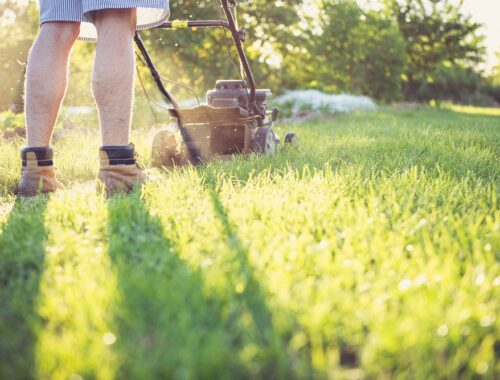Watering Techniques for a Lush and Green Lawn

A lush and vibrant lawn is the envy of every homeowner, but achieving that emerald carpet requires more than just regular mowing. Proper watering is a fundamental aspect of lawn care that often gets overlooked or misunderstood. In this comprehensive guide, we will explore the best watering techniques to help you attain and maintain a lush and green lawn that will be the pride of your neighborhood.
The Importance of Proper Lawn Watering
Before delving into specific watering techniques, it’s crucial to understand why proper lawn watering is so essential. Your lawn, like any other plant, needs water to survive and thrive. Water plays several critical roles in maintaining a healthy lawn:
1. Hydration
Grass, like all plants, requires water to stay hydrated. Without adequate water, grass blades will wilt, turn brown, and eventually die. Proper hydration ensures that your lawn remains green and vibrant.
2. Nutrient Transport
Water acts as a carrier for essential nutrients that grass needs to grow. It transports these nutrients from the soil to the roots, where they are absorbed and used for growth.
3. Temperature Regulation
Watering your lawn can help regulate soil temperature. During hot summer months, regular watering keeps the soil cooler, preventing heat stress on the grass.
4. Root Growth
Proper watering encourages deep root growth. Deep roots help grass access water and nutrients from deeper in the soil, making the lawn more resilient during dry periods.
5. Weed Prevention
A well-watered lawn with healthy grass is less susceptible to weed infestations. Thick grass can outcompete weeds for sunlight, water, and nutrients.
Now that we’ve established why watering is crucial let’s explore the best techniques to achieve a lush and green lawn.
The Best Lawn Watering Techniques
Achieving a lush and green lawn doesn’t require excessive water use; it demands a smart and efficient approach. Here are the top watering techniques to ensure your lawn thrives:
1. Water Early in the Morning
Timing is crucial when it comes to watering your lawn. The best time to water is early in the morning, typically between 4 a.m. and 10 a.m. During this period, temperatures are cooler, and winds are usually calm. Watering in the morning allows the grass to absorb moisture before the heat of the day, reducing the risk of evaporation.
2. Water Deeply and Infrequently
One of the most common mistakes homeowners make is shallow and frequent watering. This encourages shallow root growth and makes your lawn more susceptible to drought stress. Instead, aim for deep and infrequent watering.
When you water, provide enough moisture to penetrate at least 6 inches into the soil. This encourages the grass to develop deep roots, which are better equipped to access water during dry periods. Infrequent watering means you water less often but thoroughly. Depending on factors like soil type and weather conditions, you might water every 1 to 3 weeks.
3. Use the Right Amount of Water
Determining the right amount of water for your lawn can be challenging, as it depends on factors like grass type, soil type, and climate. However, a general guideline is to provide your lawn with about 1 to 1.5 inches of water per week, including rainfall.
To measure how much water your lawn is receiving, you can use a rain gauge or simply place empty containers (like empty tuna cans) around the lawn. This will help you determine how long you need to run your sprinklers to achieve the desired amount.
4. Invest in a Quality Sprinkler System
Investing in a good sprinkler system can make lawn watering more efficient and less time-consuming. There are several types of sprinkler systems to choose from, including oscillating, rotor, and drip systems. The choice depends on the size and layout of your lawn.
Consider installing a smart irrigation system that can adjust watering schedules based on weather conditions and soil moisture levels. These systems can save water and ensure your lawn gets the right amount of moisture.
5. Avoid Overwatering
Overwatering is a common mistake and can be as harmful as underwatering. When you overwater, the soil becomes waterlogged, and the roots suffocate. Signs of overwatering include wilting, yellowing grass, and the presence of fungal diseases like mold and mildew.
To avoid overwatering, monitor your lawn for signs of stress and adjust your watering schedule accordingly. Additionally, make sure your sprinklers are working correctly and not leaking, as this can lead to excessive moisture.
6. Water Evenly
Ensure that water is distributed evenly across your lawn. Uneven watering can result in patchy growth, with some areas becoming lush while others wither. To achieve even watering, check the coverage of your sprinklers and adjust their positioning as needed.
7. Consider Soil Type
The type of soil in your lawn plays a significant role in how it retains water. There are three primary types of soil: sandy, loamy, and clay. Sandy soil drains quickly but doesn’t retain moisture well, while clay soil retains water but drains poorly. Loamy soil, a mixture of both, is ideal for most grass types.
Understanding your soil type allows you to tailor your watering schedule. Sandy soil may require more frequent watering, while clay soil benefits from longer intervals between watering to prevent waterlogging.
8. Watch the Weather
Pay attention to weather forecasts, as they can help you adjust your watering schedule. If rain is predicted, you may need to skip a scheduled watering session. Conversely, during hot and dry spells, you may need to water more often.
9. Use Mulch
Applying a layer of mulch around trees, shrubs, and garden beds can help retain soil moisture and reduce the amount of water needed for those areas. Mulch acts as a barrier, preventing water from evaporating quickly and keeping the soil consistently moist.
10. Perform a Sprinkler Audit
Periodically assess your sprinkler system’s efficiency. Check for clogged nozzles, misaligned sprinkler heads, and leaks. A well-maintained system ensures that water is distributed evenly and efficiently.
Adjusting Watering Based on Season
Lawn watering needs change with the seasons. Understanding these seasonal variations is crucial for maintaining a lush and green lawn year-round.
Spring
In the spring, your lawn is coming out of dormancy and actively growing. Typically, the weather is milder, and rainfall is more frequent. Monitor your lawn and water as needed, ensuring that the soil doesn’t become waterlogged.
Summer
Summer brings higher temperatures and increased evaporation rates. During this season, you may need to water more frequently. However, remember the importance of deep watering to encourage strong root growth. Early morning remains the best time to water, as it allows the grass to dry before evening, reducing the risk of fungal diseases.
Fall
As temperatures cool in the fall, your lawn’s growth rate may slow down. Adjust your watering schedule accordingly, reducing the frequency of watering sessions. Focus on deep watering to prepare the grass for winter.
Winter
In many regions, lawns go dormant during the winter, requiring minimal or no watering. However, if you live in an area with mild winters, occasional watering may be necessary to prevent drought stress.
Signs of Overwatering and Underwatering
To fine-tune your lawn watering techniques, it’s essential to recognize the signs of both overwatering and underwatering. Here’s how to identify each:
Signs of Overwatering
- Wilting Grass: Surprisingly, overwatered grass can exhibit signs of wilting similar to underwatered grass. This is because overwatering leads to root suffocation, preventing the grass from taking up water.
- Yellowing Grass: Overwatered grass may turn yellow or pale green due to a lack of oxygen in the root zone.
- Fungal Growth: Excessive moisture can lead to fungal diseases such as mold and mildew. Look for patches of mold or a slimy, algae-like growth on the soil surface.
- Weeds and Moss: Overwatered lawns can become breeding grounds for weeds and moss, which thrive in damp conditions.
- Runoff: If you notice water running off your lawn and pooling in low areas or on sidewalks, it’s a clear sign of overwatering.
Signs of Underwatering
- Wilted Grass: The most obvious sign of underwatering is wilted, limp grass blades. These blades may appear dull or grayish-green.
- Footprints Remain: If footprints or mower tracks remain visible on your lawn after walking or mowing, it’s a sign that the grass lacks moisture.
- Dry, Cracked Soil: Inspect the soil around your lawn. If it’s dry and cracked, it’s a strong indication that the grass is not receiving enough water.
- Dull, Lifeless Appearance: An underwatered lawn will have a dull, lifeless appearance, with grass blades that lose their vibrancy.
Lawn Watering FAQ
To further assist you in your quest for a lush and green lawn, let’s address some common questions and concerns about lawn watering.
1. How much water does my lawn need?
The amount of water your lawn needs depends on factors such as grass type, soil type, climate, and the time of year. As a general guideline, aim for 1 to 1.5 inches of water per week, including rainfall. Use a rain gauge or empty containers placed around the lawn to measure water accumulation accurately.
2. How can I conserve water while watering my lawn?
Conserving water is not only environmentally responsible but also cost-effective. To conserve water while maintaining a healthy lawn:
- Follow the deep and infrequent watering technique.
- Fix any leaks or issues with your sprinkler system promptly.
- Install a smart irrigation system that adjusts watering schedules based on weather and soil moisture levels.
- Use mulch in garden beds and around trees and shrubs to retain moisture.
- Collect rainwater in barrels and use it for lawn watering when possible.
3. Is it better to water in the morning or at night?
Watering in the morning, typically between 4 a.m. and 10 a.m., is generally recommended. This allows the grass to absorb moisture before the heat of the day, reducing the risk of evaporation and fungal diseases. Watering at night can create ideal conditions for fungal growth due to prolonged moisture on the grass blades.
4. Can I water my lawn too much?
Yes, overwatering your lawn can be detrimental. It can lead to shallow root growth, root suffocation, and fungal diseases. It’s important to strike a balance between providing enough moisture for your lawn to thrive and avoiding excessive watering.
5. Can I water my lawn during a drought or water restriction?
During drought conditions or water restrictions, it’s essential to be mindful of water conservation. You may need to adjust your lawn watering schedule and prioritize the most critical areas of your lawn. Consider using drought-resistant grass varieties and applying a layer of mulch to retain soil moisture.
6. How can I tell if my lawn needs water?
A simple way to check if your lawn needs water is the “footprint test.” Walk across your lawn, and if your footprints remain visible or the grass doesn’t bounce back, it’s time to water. Additionally, monitor the color and texture of the grass. Wilting, yellowing, or dullness can indicate a need for water.
Achieving a lush and green lawn is a rewarding endeavor that requires a combination of proper care and smart lawn watering techniques. By understanding the importance of hydration, nutrient transport, temperature regulation, root growth, and weed prevention, you can create an environment in which your grass thrives.
Remember to water early in the morning, water deeply and infrequently, use the right amount of water, invest in a quality sprinkler system, avoid overwatering, water evenly, consider soil type, watch the weather, and use mulch to retain moisture. By following these watering techniques and adjusting your watering schedule based on seasonal changes, you can enjoy a lawn that’s the envy of your neighborhood—a lush, green oasis of natural beauty and vitality.
Generated by ChatGPT
You May Also Like

What Is The Best Time Of Year To Aerate My Lawn In Roswell, Georgia?
April 22, 2023
Professional Lawn Care Service vs. DIY: Making the Right Choice for Your Lawn in Roswell, Georgia
June 2, 2023

